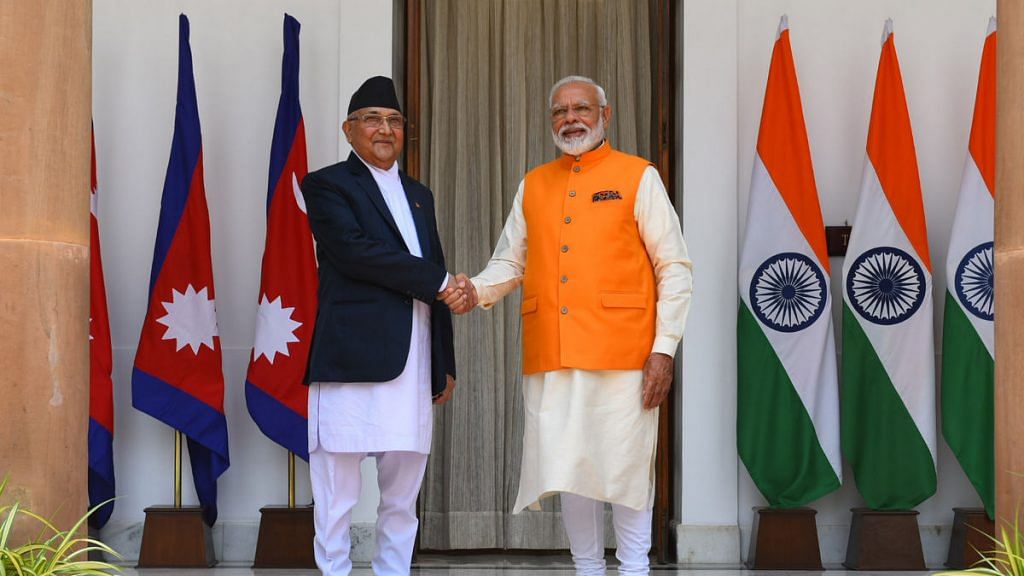When Khadga Prasad Sharma Oli was elected Nepal’s prime minister for the first time in 2015, a sense of chill had started descending on the bilateral ties between India and Nepal. Oli’s election brought a Communist government in the Himalayan nation.
But if the first nine-month tenure saw a defiant Oli challenge India on many issues, New Delhi took solace in his moderate Communism the second time around, when he was back as the PM in 2018 with the support of former Maoist rebels. Delhi hoped Oli would have the skills to balance Nepal’s relationship with two of its gigantic neighbours – India and China.
But that notion has now disappeared in Delhi’s diplomatic and strategic communities with Oli doing the unexpected: taking India head-on.
From ridiculing India’s national emblem to changing Nepal’s political map for the first time in many decades, Oli set off a chain of events that few in Delhi had anticipated. This is why Nepal’s Prime Minister K.P. Sharma Oli is ThePrint’s Newsmaker of the Week.
Also read: Indian politicians, media focusing on ‘Hindu’ Nepal is not only pointless but harmful too
When India didn’t act
The new map of Nepal shows the disputed regions of Kalapani, Limpiyadhura, and Lipu Lekh, which fall on the east of Mahakali river, as part of Nepal’s territory.
K.P. Sharma Oli, who had spent 14 years in jail (1973-1987) for opposing the monarchy, proudly claimed in Nepal’s parliament that he would “reclaim” the disputed region at “any cost”.
While it is true that Oli enjoys a considerably comforting relationship with China than he does with India, New Delhi cannot put the blame singularly on the Nepal PM for not resolving the boundary matter diplomatically when the time was right.
The alarm bells had started ringing in 2018 when Oli came to power for the second time. But New Delhi chose to look the other way despite Prime Minister Narendra Modi’s repeated assertion on ‘Neighbourhood First’ policy.
India had got a taste of Oli’s style of governance in 2015 itself when his government succeeded in promulgating Nepal’s new constitution, which New Delhi saw as being flawed because it allegedly did not cover the aspirations of a section of people from the Terai region – Madhesis and Tharus.
This led to a massive border blockade by the Madhesis and Nepal’s other ethnic minorities in 2015, which allegedly had India’s “support”, and marked a sharp change in India-Nepal ties.
And yet Oli, in his second tenure, was crediting himself for bringing in “peace, stability and prosperity” in Nepal, and thereby ending the cycle of “political uncertainty and frequent change of governments.”
Also read: Not Nepal map, the real conflict is within KP Oli’s Communist Party
An ultra-nationalist who once was pro-India
Last year, in his address to the Oxford Union Society, Oli had the democratic system of governance. “We must admit that there is no single formula of democracy and no fixed model of development,” he had said, adding that “democracy, at times, becomes a formality and a rhetoric, not substantive and people-centred”.
A feisty teenager Oli, who hailed from Nepal’s Jhapa district bordering India, started rising in active power politics after he proved his mettle in the ‘Jhapa revolt’ or the peasant uprising against landowners in 1969 that “shook the country awake”.
When he was released from prison in 1987, Oli began to consolidate the Left front and launched the Communist Party of Nepal (United Marxist Leninist).
Oli was seen as pro-India for the role he played in 1998 during the Mahakali Treaty, which many Nepalese still believe was an unequal water-sharing agreement and a betrayal.
“An ultra-nationalist that Oli has now become, he is trying to correct that historic wrong. He is now trying to go down in the history of Nepal as this leader who solved all problems of the country. This is like a ‘Ramban’ (panacea) for him now,” a former Indian intelligence official, who was posted in Nepal, said on the condition of anonymity.
According to the official, while China has no role to play in Oli’s recent overzealousness with the new map, Oli is “confident” of Beijing’s support in provoking India.
Also read: With strong leaders like Rajapaksa, Hasina, Oli, is India losing dominance in South Asia?
Creating a difficult path
Many within the strategic and diplomatic circles say that Oli, in his zest to outdo his once friend but now adversary Pushpa Kumar Dahal ‘Prachanda’, is creating a scenario wherein the road ahead with India will be “arduous and difficult”.
This explains him ridiculing India’s national emblem, the Lion Capital, and its motto ‘Satyameva Jayate (truth alone prevails)’. Oli wondered if New Delhi was now following the motto of “simheva jayate” (lion wins).
“Such a speech is intemperate. It only makes the road ahead between India and Nepal arduous and difficult. But because it is an important relationship we should ignore it for the sake of the relationship. We cannot afford to be at loggerheads with each other,” said veteran diplomat Jayant Prasad, who was India’s former envoy to Kathmandu.
When Prachanda was the Prime Minister of Nepal, Oli played a key role between New Delhi and Kathmandu. But now, faced with tremendous pressure from intra-party troubles, Oli is hardening his stance against India in an unprecedented manner.
Views are personal.
